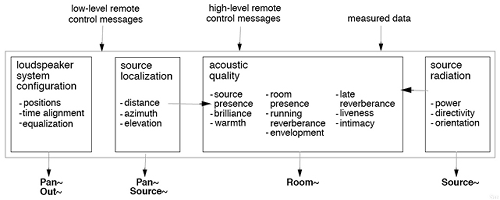Spatialisateur
Spat Introduction
|
High Level Control and the Spat OperIntroduction
By associating the signal processing modules described in Chapter 3, a complete spatial processing chain can be constructed, starting from the captured or synthesized sounds to the distribution of the processed sounds to the loudspeakers. For the musician or the sound engineer, it is preferable to use a control interface that is not simply the reunion of the low-level control interfaces of the different signal processing objects, but rather is made of a selection of high-level command controls (see figure). The Max graphical programming environment allows the user to build his/her own custom control interface, capable of sending control messages to the DSP objects, according to each object's control syntax. Spat_OPer is a high-level control interface of this kind. Its role is to provide a reduced set of controls which describe the reproduced effect through quantities that are intuitive to the user and perceptually relevant from the point of view of the listener. The core of Spat_OPer is a perceptual control module based on research carried out in the Ircam room acoustics team on the objective and perceptual characterization of room acoustic quality [6, 10]. This control interface can be set to imitate the acoustics of an existing room and allows to interpolate or extrapolate naturally towards a different acoustic quality. Furthermore, Spat_OPer can take into account measured data describing how the loudspeaker system, coupled with the listening room, will "filter" the output signals, observed from the reference listening position. These data will be used by an automatic compensation procedure to set the DSP parameters so as to ensure, as much as possible, that the specified acoustic quality be realized at this reference position. The graphical user-interface in Spat_OPer is divided into four sections (see figure below):
 Functional Description of Spat_Oper Graphical User Interface Spat_OPer is a high-level control object (according to the definition given in Chapter 2) which can receive three types of remote control messages:
|
© CNAC-GP/Ircam and Espaces Nouveaux |